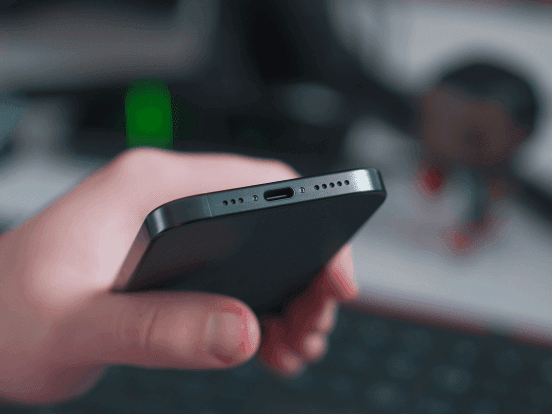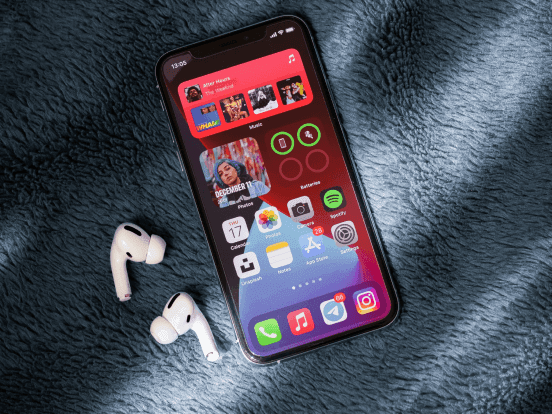
Transfer Files from Mac to iPhone via Wireless and Wired Approaches
 Simon Brown • Apr 17, 2024
Simon Brown • Apr 17, 2024Mac devices are extensively used for day-to-day tasks in professional settings due to their security and processing speed. However, workers often need to transfer files from Mac to iPhone because they can't carry Mac devices everywhere for presentations or meetings. In such situations, they face problems figuring out the most appropriate and reliable method for file transfer because of their fast-paced work situations.
To avoid such difficulties, this guide has explained the top methods on how to transfer files from Mac to iPhone. So, review this guide thoroughly and learn wireless and wired approaches to file sharing with step-by-step guides.
Part 1. Can I Transfer Files from Mac to iPhone?
The short answer is yes; you can transfer files from MacBook to iPhone, and countless wired and wireless methods are available for this purpose. Among such methods is iCloud syncing of files, which is appropriate for individuals looking for a secure file transfer.
Besides, the AirDrop feature is available on Apple Devices, where no additional setup, installation, or internet is required. Meanwhile, email is another trending mode of file transfer in professional working spaces because of its ample storage for important data archives.
If you frequently use an instant messaging app such as Viber or WhatsApp, they can also be used to share files conveniently without compatibility issues. Moreover, several third-party apps have been launched to facilitate file sharing, and one of the exclusive apps is mentioned in the guides below.
Part 2. Exploring Wireless and Wired Approaches for MacBook to iPhone File Transfer
After clearing up the confusion related to MacBook to iPhone transfer, it's time to explore the top ways that bring convenience and effectiveness to elevate your productivity. Henceforth, count on this section to find common approaches to your query: How do I transfer files from Mac to iPhone?
Method 1. Via Avica Remote Desktop (Wireless)
If we begin the discussion with an industry-leading method, Avica Remote Desktop software will emerge at the top. It is a third-party application that facilitates iOS-to-macOS file transfer as it is compatible with iOS, Android, Mac, and Windows. Besides, this file transfer software features a patented protocol for high-speed file transfer where file size can never hinder the speed.
Avica can also transfer unlimited files across devices without any file format restrictions. In addition to that, users reserved about session security should know that Avica has comprehensive AES-256 encryption for end-to-end security. Overall, it’s a remote desktop app that allows you to control the on-screen activities of remote devices in the session and elevate your remote collaborations.
Explore How Avica is a Leading Platform in Remote Desktop Apps
- Screen Recording: If you are collaborating on a project, Avica provides a screen recording feature to capture on-screen activities. Through it, you can pause the recording and restart where required to keep an archive of the remote session.
- Remote Shutdown/Restart: Avica allows you to remotely control the connected host devices, which also includes shutting down and rebooting them. It is crucial in several scenarios, such as troubleshooting problems remotely or testing a newly developed feature of an app.
- Device List: Users always want to manage previously connected remote devices easily in the future. For this purpose, Avica allows you to create groups and add as many devices to the list as possible.
How to Transfer Files from Mac to iPhone Using Avica Remote Desktop
Using Avica is simple because of its intuitive interface, which is easy to navigate and user-friendly. Nevertheless, you should explore how to send a file from Mac to iPhone efficiently through the given steps so you can better understand its ease of use.
You can easily download Avica software by clicking the button provided below or download Avica mobile app from Google Play and App Store. For more detailed information regarding Avica App downloads, please visit the official Avica download page. It is important to note that Avica ensures the safety and virus-free nature of all products available on its official website or app store. Feel confident in downloading Avica from these trusted sources.
Step 1: Allow Remote Access from Mac to Establish Remote Session
Successfully install the Avica App on your devices and access its user-friendly interface. Now, activate the “Allow Remote Access to This Device via Your Credentials” on your Mac device and copy the displayed credentials.

Step 2: Use Avica ID and Password to Access Download Files Option
Launch Avica on your iPhone and insert the “Avica ID” in the text box under the “Remote Connection.” Then, hit the “File Transfer” button and add your previously obtained “Password” to establish the remote connection.

Step 3: Download Files on Your iPhone and Get Them in Files App
From the next screen, tap the “Download Files” option and access your Mac’s Finder to browse files. Locate files on your Mac using your iPhone, select them, and hit the "Download" button to start transferring them. Afterward, choose one and press the "Share" icon from the top-right side. Lastly, touch the "Save to Files" option, and the files will be transferred to the Files app.

Method 2. With Finder (Wired)
Alternative to iTunes, Apple introduced the Finder app on new Mac devices, which can facilitate the file transfer process. However, it needs the latest macOS version for seamless connectivity, a USB connection, and a user guide to learn how to transfer a file from Mac to iPhone via Finder. That's why the following guide has a step-by-step method of sharing files so you can complete the process without hindrance.
Step 1: First, connect your Mac to your iPhone using your Apple-certified cable and open your Mac's Finder app. Click on your iDevice from the left side panel and trust your devices from Mac and iPhone via passcode. Later, tap the "Files" option to see a list of apps sharing files to and from your iPhone.

Step 2: Now, hit the “Command + N” keys from your keyboard and open another Finder window. Using it, drag a file and drop it on your desired app in the Files tab. Finally, you can visit your iPhone’s File App and “On My iPhone” folder to check the transferred files by accessing the apps folder.

Method 3. With iCloud (Wireless)
Apple users can stay up to date while using iCloud because it allows you to access files on all devices once you upload them to iCloud. Moreover, you can upload all common and unique formats on iCloud Drive, such as PDF, PPT, JPEG, MP4, MD, and RTF.
However, you will only get 5GB of storage in the free plan to manage your Apple device. To transfer files from MacBook to iPhone via iCloud, follow the step-by-step guide discussed below:
Step 1: Initiate the process by accessing any browser installed on your Mac and signing in to iCloud.com with the Apple ID credentials. Afterward, tap the "iCloud Drive" icon from the app widget or through its widget, redirecting you to the iCloud Drive app.

Step 2: Once you reach Apple's iCloud Drive, select "Upload" from the top of the page to select and upload the files from your Mac. Once the upload process is completed, you can access the files from the Files app on your iPhone.

Method 4. Using AirDrop (Wireless)
Apple launched its revolutionary file transfer technology called AirDrop in 2011 on MacBook and in 2013 on its iOS devices, which effectively transfers data without cable wire. This method lets you share any file format and, theoretically, any file size with your Apple devices, but the process causes trouble when the number of files is larger.
Additionally, you can only transfer files from a MacBook to an iPhone when both devices are within 30 feet (10 meters). To learn how this feature works across your Apple devices, go through this simplified guide:
Step 1: Begin by accessing the Control Centre of your MacBook from the top toolbar. Then, turn on the AirDrop visibility from Contacts to Everyone and enable the AirDrop from your iPhone to Everyone from the Control Center.

Step 2: After enabling AirDrop on both Apple devices, launch the Finder and locate the files you want to transfer to your iPhone. Then, Control-Click on them to choose the “Share” option from the list and proceed with the “AirDrop” feature. Here, select your iPhone’s name and conclude the process by accepting the confirmation message on your iPhone.

Method 5. Via Email (Wireless)
Using email to transfer files is a traditional method that most people have adopted to communicate during their business hours. However, if you are thinking of using Gmail to attach files, then keep in mind that it only supports 25MB of file size.
You can use this method to transfer all common formats, such as MP3, MP4, PDF, PPT, DOCX, and JPEG, to transfer files. Anyhow, you can follow the simple steps mentioned below on how to transfer data from Mac to iPhone via Gmail:
Step 1: Initiate the process by accessing your Gmail account and pressing the "Compose" button from the left panel to create a new email. Then, enter the receiver's email address and attach the files by clicking on the "Attach Files" symbol. From this, you will be able to upload files, wait for them to load, and hit the "Send" button.

Step 2: Following this, navigate to the Gmail app on your iPhone and access the file that you have sent from the macOS device. To access the file-saving options, press the "Share" icon from the top-right corner. Afterward, select the "Save to Files" option to transfer the file to your iPhone's Files app.

Method 6. Via Chats-Viber (Wireless)
Instant messaging apps like Viber are used in day-to-day communication, but several people are unaware that they can also move files through them. If you are also one of them, go through this guide and learn how to transfer files from Mac to iPhone through Viber. Before moving, remember that Viber is limited to sharing a maximum of 200MB files, and you need to shift to another platform if your file is larger.
Step 1: Set up your Viber account on your Mac device and open your chat with a trusted contact number. Next, tap the “+ (Add)” icon from the bottom and select files from the Finder for sharing.

Step 2: Move toward your iPhone’s Viber app and access the chat that you use to share the file. There, open the file and use the “Share” icon from the bottom-left side to press the “Save to Files” option.

Part 3. Which is the Most Suitable Way to Transfer Files from Mac to iPhone?
The methods mentioned above are good for sending files from Mac to iPhone. For your ease, let's compare these methods to evaluate the effectiveness and limitations of achieving a successful transferring process. Using the Finder app requires a USB cable to initiate the process, and due to its unavailability or any issue, this method will not be reliable.
Moving to AirDrop is considerably the finest approach, but it is limited to the nearby Apple devices. Meanwhile, the email method has a limit of 25MB, whereas Viber supports a 200MB size limit, and both require a stable internet connection. Amongst these, Avica is the most reliable way to transfer files between macOS and iOS devices because it does not limit you to a file limit and has a 100 times faster speed than HTTP/FTP.
Conclusion
To sum up, we have discussed the top-rated methods to transfer files from a MacBook to an iPhone. You can choose one of the methods from Avica, AirDrop, iCloud, Viber, Email, or Finder to smoothen the transfer process.
If you are looking for an easy and quick method, Avica is an incredible tool that allows you to try to transfer files with end-to-end encryption. Notably, it has various remote access features that you can use to collaborate with devices that are thousands of miles away.

A Guide to Fix Computer is Not Recognizing iPhone: Top 6 Solutions You Must Know


6 Must-Know Approaches to Send Long Videos on iPhone: A How-to Guide


4 Effective Ways to Send Large Videos on Android

